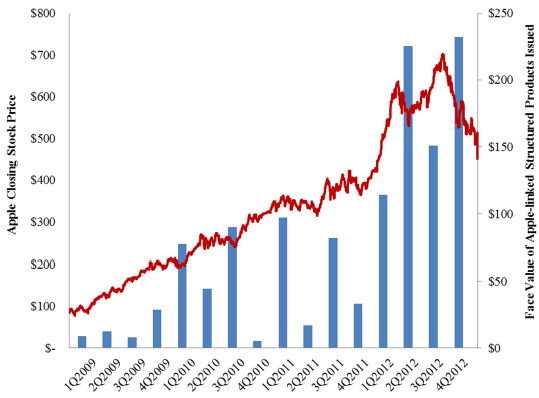Study Finds that the Average PE Investor Just Breaks Even
(Nov 2013)
Brendan Conway over at Barron's pointed out an interesting new study from the National Bureau of Economic Research entitled: Valuing Private Equity. Private Equity (PE) investments -- typically called limited partnerships (LPs) -- are long-term, illiquid securities representing (perhaps not surprisingly) an equity interest in a private company. Investors are typically referred to as limited partners. The study notes that while private equity returns tend to be high, "it remains controversial...
Fidelity to Launch Mutual Fund Based on Hedge Fund Strategy
(Oct 2013)
We see it again and again: complex investment strategies packaged into traditionally conservative investments. We have seen corporate debt linked to exotic derivatives positions (structured products), exchange-traded products linked tocomplex futures positions (commodities and volatility ETPs), variable annuities linked to options strategies (structured product based variable annuities), and even certificates of deposit with complex payoff structures (structured CDs). Now, we are seeing more...
Foreign Exchange Rate Fixing
(Jun 2013)
Bloomberg News recently reported that traders at some of the world's largest banks have been in the business of rigging foriegn exchange (FX) rates. An FX rate essentially tells you how much of one currency you can buy with another currency: for example, currently you can buy about 100 Japanese yen for each US dollar. The rates affect "trillions of dollars of investments" according to Bloomberg, since they are used for the valuation of portfolios, derivatives, and even equity and fixed...
Investors Returning to Capital-at-Risk Products
(May 2013)
Yakob Peterseil of Risk.net recently noted that "[b]anks are boosting issuance of leveraged notes linked to US equity indexes and notes that pay out when yield curves steepen." According to the article, reverse convertibles and buffered notes are seeing a resurgence as investors begin to be more optimistic about stock market growth. In addition, principal-protected structures like structured certificates of deposit and principal-protected notesare falling out of favor as attractive terms are...
529 College Savings Plans Underperform Similar Mutual Funds -- Morningstar
(Apr 2013)
On Monday, Morningstar Fund Research issued their 2013 529 College-Savings Plans Industry Survey, which reviews the performance of the 529 industry in 2012. Their study finds that "college savers are continuing to invest in 529 college-saving plans at an impressive clip, even though their performance has lagged that of similar funds in recent years."
529 Plans are typically run by states and are used by investors to save for future education expenses such as college tuition on a...
Goldman Sachs Uses JOBS Act to Sidestep Volcker Rule
(Apr 2013)
Evan Weinberger at Law360 is reporting that Goldman Sachs may have found a way around the Volcker Rule--the ban on proprietary trading by banks, which also prohibits sponsoring hedge funds and private equity funds--by using another controversial regulatory measure, the 2012 JOBS Act (of which we have spoken before):
By setting up an independent business development company in which it will hold a minority stake and limited leverage exposures, Goldman will be able to engage in at least limited...
Apple's Declining Stock Price and Structured Products
(Jan 2013)
Jason Zweig at the Wall Street Journal has an excellent piece on a part of the Apple story that hasn't gotten much press: many equity-linked structured products are linked to the common stock of Apple.
SLCG has recently completed an analysis of the market value of outstanding structured products linked to Apple common stock (AAPL). In the following figure, we plot the total quarterly issuance of AAPL-linked structured products in our database since the first quarter of 2009.
As Apple's common...
What a CDO 'Resurgence' Might Mean for Investors
(Jan 2013)
Kaitlin Ugolik at Law360 had an article on Wednesday discussing the recent "bump in demand for collateralized debt obligations." CDOs are complex derivatives that pool assets together and split the risk of that portfolio into tranches which are then sold to investors. CDOs have been implicated in the financial crisis of 2008 and have seen a strong drop-off in new issuances since, though that tide may now be changing.
According to the article, some lenders are predicting a large increase in...
Back to the Future: Stock Prices Quoted with Fractions
(Nov 2012)
The Wall Street Journal recently reported that the SEC is considering reverting back to an old system in which stock prices were quoted using fractions. Using fractions for stock prices in the US has its roots in a Spanish colonial currency whose smallest denomination was 1/8 of a doubloon, hence prices were quoted in eights. The NYSE, founded in 1792 within the Buttonwood agreement, modeled their listing system off the Spanish system.
The largest number used for the denominator in the...
Vanguard Abandons MSCI and MSCI's Share Price Crashes
(Oct 2012)
A few weeks ago, the Wall Street Journal reported that Vanguard is replacing the benchmarks on nearly two dozen of its index funds currently provided by MSCI and replacing them with benchmarks provided by either FTSE or the Center For Research In Security Prices (CRSP) at the University of Chicago. See the press release dated October 2, 2012.
This is clearly great news for FTSE since this index change by Vanguard makes them the "third-largest equity exchange traded product index benchmark...

